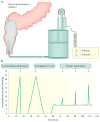Expert consensus document: Advances in the evaluation of anorectal function
- PMID: 29636555
- PMCID: PMC6028941
- DOI: 10.1038/nrgastro.2018.27
Expert consensus document: Advances in the evaluation of anorectal function
Abstract
Faecal incontinence and evacuation disorders are common, impair quality of life and incur substantial economic costs worldwide. As symptoms alone are poor predictors of underlying pathophysiology and aetiology, diagnostic tests of anorectal function could facilitate patient management in those cases that are refractory to conservative therapies. In the past decade, several major technological advances have improved our understanding of anorectal structure, coordination and sensorimotor function. This Consensus Statement provides the reader with an appraisal of the current indications, study performance characteristics, clinical utility, strengths and limitations of the most widely available tests of anorectal structure (ultrasonography and MRI) and function (anorectal manometry, neurophysiological investigations, rectal distension techniques and tests of evacuation, including defecography). Additionally, this article provides our consensus on the clinical relevance of these tests.
Conflict of interest statement
E.V.C. has received honoraria for teaching from MMS/Laborie.
S.M.S. has received honoraria for teaching from MMS/Laborie.
J.R.-T. has received research funding from Newton Foundation-CONACYT, Sanfer and Asofarma Laboratories, speaker fees from Covidien/Medtronics, Takeda, Allergan, Astra Zeneca, Sanofi and Sanfer.
F.M. has served as consultant for Medtronic, Laborie.
A.B. has licensed intellectual property in a portable anorectal manometry device to Medspira Inc.
M.F. has received research funding from Covidien/Medtronic, speaker fees from Covidien/Medtronic, Sandhill, MMS/Laborie, Reckitt Benckiser, and Mui Scientific.
S.S.R. has served on advisory boards for Forest labs, Synergy Pharmaceuticals, Vibrant Ltd, Intone, and has received research grants from Forest labs, Synergy, InTone, and Medtronic. H.H. and A.M. declare no competing interests.
Figures





References
-
- Palit S, Lunniss PJ, Scott SM. The physiology of human defecation. Dig Dis Sci. 2012;57:1445–64. - PubMed
-
- Johanson JF, Lafferty J. Epidemiology of fecal incontinence: the silent affliction. Am J Gastroenterol. 1996;91:33–6. - PubMed
-
- Higgins PD, Johanson JF. Epidemiology of constipation in North America: a systematic review. Am J Gastroenterol. 2004;99:750–9. - PubMed
Publication types
MeSH terms
Grants and funding
LinkOut - more resources
Full Text Sources
Other Literature Sources
Medical
Research Materials
Miscellaneous

